Coms 018 Final Project: Co-cultural Communication Theory Report
VerifiedAdded on 2022/12/15
|7
|2153
|126
Report
AI Summary
This report provides a comprehensive analysis of co-cultural communication theory, focusing on the work of Mark Orbe. It begins by defining the theory, which explores how individuals from marginalized groups communicate within a dominant culture. The report explains the core concepts, including communication strategies like assimilation, accommodation, and separation, as well as the influence of feminist theories. It details the theory's origins, the contributions of Mark Orbe, and identifies inherent weaknesses such as the limited scope of communication strategies and potential for misinterpretation. The report then applies the theory to a real-life scenario involving gendered communication in the workplace, providing a practical example of how co-cultural dynamics manifest. Finally, the report emphasizes the importance of understanding this theory for recognizing the structures that shape intercultural communication. The analysis draws on multiple sources and concludes by highlighting the significance of the theory in understanding the nuances of human interaction.
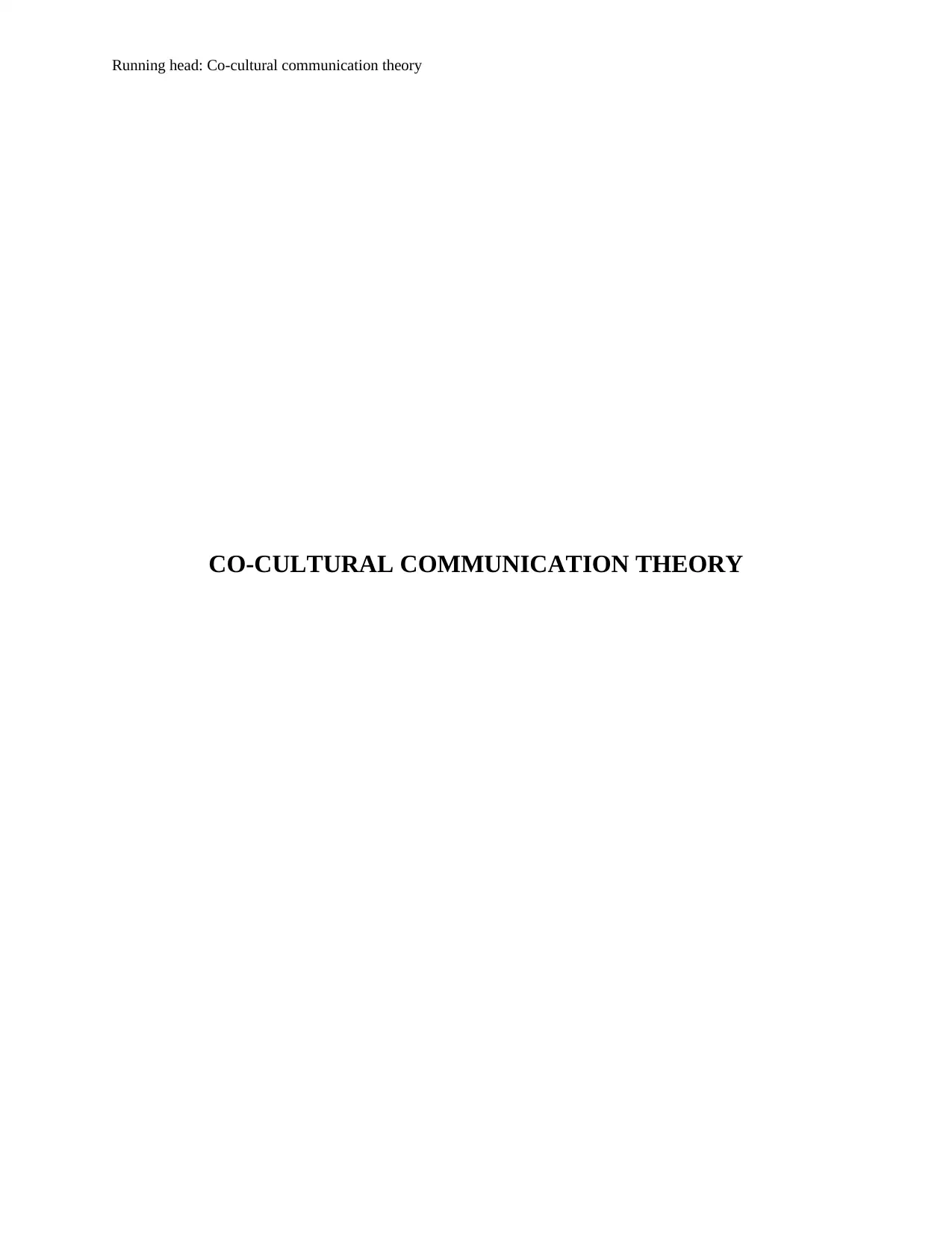
Running head: Co-cultural communication theory
CO-CULTURAL COMMUNICATION THEORY
CO-CULTURAL COMMUNICATION THEORY
Paraphrase This Document
Need a fresh take? Get an instant paraphrase of this document with our AI Paraphraser
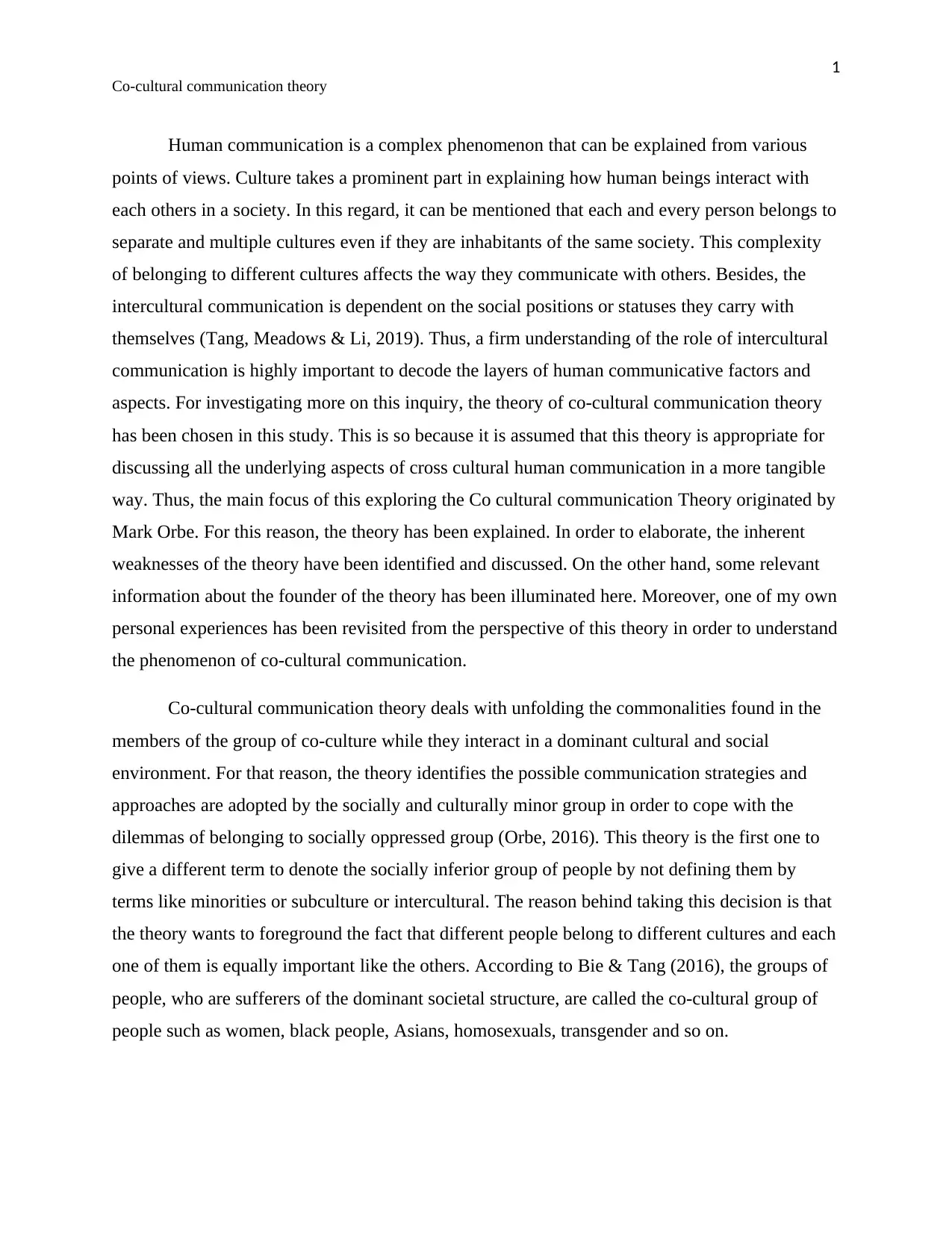
1
Co-cultural communication theory
Human communication is a complex phenomenon that can be explained from various
points of views. Culture takes a prominent part in explaining how human beings interact with
each others in a society. In this regard, it can be mentioned that each and every person belongs to
separate and multiple cultures even if they are inhabitants of the same society. This complexity
of belonging to different cultures affects the way they communicate with others. Besides, the
intercultural communication is dependent on the social positions or statuses they carry with
themselves (Tang, Meadows & Li, 2019). Thus, a firm understanding of the role of intercultural
communication is highly important to decode the layers of human communicative factors and
aspects. For investigating more on this inquiry, the theory of co-cultural communication theory
has been chosen in this study. This is so because it is assumed that this theory is appropriate for
discussing all the underlying aspects of cross cultural human communication in a more tangible
way. Thus, the main focus of this exploring the Co cultural communication Theory originated by
Mark Orbe. For this reason, the theory has been explained. In order to elaborate, the inherent
weaknesses of the theory have been identified and discussed. On the other hand, some relevant
information about the founder of the theory has been illuminated here. Moreover, one of my own
personal experiences has been revisited from the perspective of this theory in order to understand
the phenomenon of co-cultural communication.
Co-cultural communication theory deals with unfolding the commonalities found in the
members of the group of co-culture while they interact in a dominant cultural and social
environment. For that reason, the theory identifies the possible communication strategies and
approaches are adopted by the socially and culturally minor group in order to cope with the
dilemmas of belonging to socially oppressed group (Orbe, 2016). This theory is the first one to
give a different term to denote the socially inferior group of people by not defining them by
terms like minorities or subculture or intercultural. The reason behind taking this decision is that
the theory wants to foreground the fact that different people belong to different cultures and each
one of them is equally important like the others. According to Bie & Tang (2016), the groups of
people, who are sufferers of the dominant societal structure, are called the co-cultural group of
people such as women, black people, Asians, homosexuals, transgender and so on.
Co-cultural communication theory
Human communication is a complex phenomenon that can be explained from various
points of views. Culture takes a prominent part in explaining how human beings interact with
each others in a society. In this regard, it can be mentioned that each and every person belongs to
separate and multiple cultures even if they are inhabitants of the same society. This complexity
of belonging to different cultures affects the way they communicate with others. Besides, the
intercultural communication is dependent on the social positions or statuses they carry with
themselves (Tang, Meadows & Li, 2019). Thus, a firm understanding of the role of intercultural
communication is highly important to decode the layers of human communicative factors and
aspects. For investigating more on this inquiry, the theory of co-cultural communication theory
has been chosen in this study. This is so because it is assumed that this theory is appropriate for
discussing all the underlying aspects of cross cultural human communication in a more tangible
way. Thus, the main focus of this exploring the Co cultural communication Theory originated by
Mark Orbe. For this reason, the theory has been explained. In order to elaborate, the inherent
weaknesses of the theory have been identified and discussed. On the other hand, some relevant
information about the founder of the theory has been illuminated here. Moreover, one of my own
personal experiences has been revisited from the perspective of this theory in order to understand
the phenomenon of co-cultural communication.
Co-cultural communication theory deals with unfolding the commonalities found in the
members of the group of co-culture while they interact in a dominant cultural and social
environment. For that reason, the theory identifies the possible communication strategies and
approaches are adopted by the socially and culturally minor group in order to cope with the
dilemmas of belonging to socially oppressed group (Orbe, 2016). This theory is the first one to
give a different term to denote the socially inferior group of people by not defining them by
terms like minorities or subculture or intercultural. The reason behind taking this decision is that
the theory wants to foreground the fact that different people belong to different cultures and each
one of them is equally important like the others. According to Bie & Tang (2016), the groups of
people, who are sufferers of the dominant societal structure, are called the co-cultural group of
people such as women, black people, Asians, homosexuals, transgender and so on.
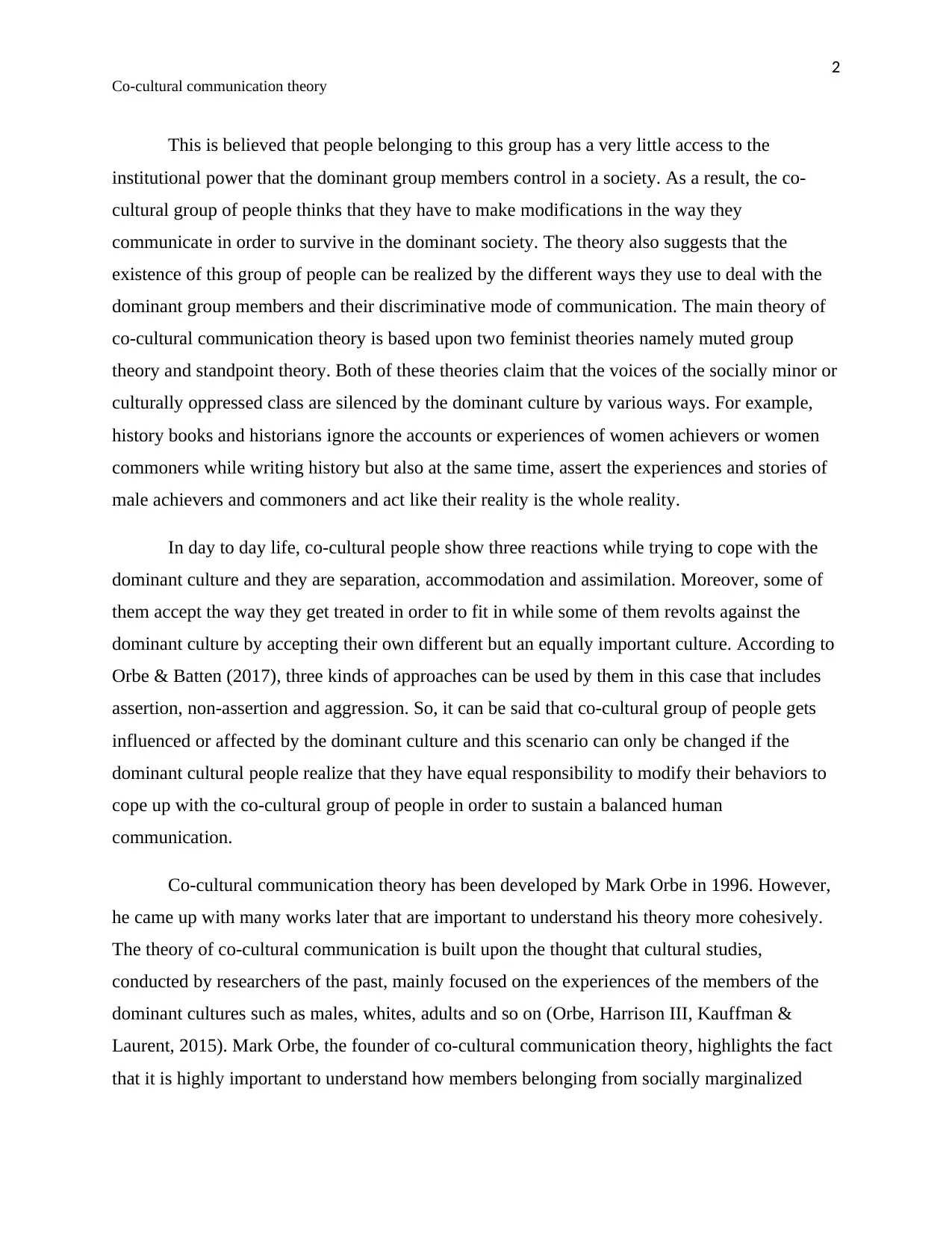
2
Co-cultural communication theory
This is believed that people belonging to this group has a very little access to the
institutional power that the dominant group members control in a society. As a result, the co-
cultural group of people thinks that they have to make modifications in the way they
communicate in order to survive in the dominant society. The theory also suggests that the
existence of this group of people can be realized by the different ways they use to deal with the
dominant group members and their discriminative mode of communication. The main theory of
co-cultural communication theory is based upon two feminist theories namely muted group
theory and standpoint theory. Both of these theories claim that the voices of the socially minor or
culturally oppressed class are silenced by the dominant culture by various ways. For example,
history books and historians ignore the accounts or experiences of women achievers or women
commoners while writing history but also at the same time, assert the experiences and stories of
male achievers and commoners and act like their reality is the whole reality.
In day to day life, co-cultural people show three reactions while trying to cope with the
dominant culture and they are separation, accommodation and assimilation. Moreover, some of
them accept the way they get treated in order to fit in while some of them revolts against the
dominant culture by accepting their own different but an equally important culture. According to
Orbe & Batten (2017), three kinds of approaches can be used by them in this case that includes
assertion, non-assertion and aggression. So, it can be said that co-cultural group of people gets
influenced or affected by the dominant culture and this scenario can only be changed if the
dominant cultural people realize that they have equal responsibility to modify their behaviors to
cope up with the co-cultural group of people in order to sustain a balanced human
communication.
Co-cultural communication theory has been developed by Mark Orbe in 1996. However,
he came up with many works later that are important to understand his theory more cohesively.
The theory of co-cultural communication is built upon the thought that cultural studies,
conducted by researchers of the past, mainly focused on the experiences of the members of the
dominant cultures such as males, whites, adults and so on (Orbe, Harrison III, Kauffman &
Laurent, 2015). Mark Orbe, the founder of co-cultural communication theory, highlights the fact
that it is highly important to understand how members belonging from socially marginalized
Co-cultural communication theory
This is believed that people belonging to this group has a very little access to the
institutional power that the dominant group members control in a society. As a result, the co-
cultural group of people thinks that they have to make modifications in the way they
communicate in order to survive in the dominant society. The theory also suggests that the
existence of this group of people can be realized by the different ways they use to deal with the
dominant group members and their discriminative mode of communication. The main theory of
co-cultural communication theory is based upon two feminist theories namely muted group
theory and standpoint theory. Both of these theories claim that the voices of the socially minor or
culturally oppressed class are silenced by the dominant culture by various ways. For example,
history books and historians ignore the accounts or experiences of women achievers or women
commoners while writing history but also at the same time, assert the experiences and stories of
male achievers and commoners and act like their reality is the whole reality.
In day to day life, co-cultural people show three reactions while trying to cope with the
dominant culture and they are separation, accommodation and assimilation. Moreover, some of
them accept the way they get treated in order to fit in while some of them revolts against the
dominant culture by accepting their own different but an equally important culture. According to
Orbe & Batten (2017), three kinds of approaches can be used by them in this case that includes
assertion, non-assertion and aggression. So, it can be said that co-cultural group of people gets
influenced or affected by the dominant culture and this scenario can only be changed if the
dominant cultural people realize that they have equal responsibility to modify their behaviors to
cope up with the co-cultural group of people in order to sustain a balanced human
communication.
Co-cultural communication theory has been developed by Mark Orbe in 1996. However,
he came up with many works later that are important to understand his theory more cohesively.
The theory of co-cultural communication is built upon the thought that cultural studies,
conducted by researchers of the past, mainly focused on the experiences of the members of the
dominant cultures such as males, whites, adults and so on (Orbe, Harrison III, Kauffman &
Laurent, 2015). Mark Orbe, the founder of co-cultural communication theory, highlights the fact
that it is highly important to understand how members belonging from socially marginalized
⊘ This is a preview!⊘
Do you want full access?
Subscribe today to unlock all pages.

Trusted by 1+ million students worldwide

3
Co-cultural communication theory
group interact with the socially dominant group members in order to understand human
communication properly.
This is so because he realized that the experiences of the dominant group members used
to be taken as the experiences or opinions of the whole society by the cultural anthropologists
(Ting-Toomey, 2014). For that reason, a major portion of society remained voiceless and most
importantly, their voices used to be dubbed metaphorically by the socially and culturally
dominant group of people. These are the reasons behind the theorist’s decision to study co-
cultural communication and to form his theory upon it.
The theory has been first mentioned in the work namely ‘Laying The Foundation For Co-
Cultural Communication Theory: An Inductive Approach To Studying Non-Dominant
Communication Strategies And The Factors That Influence Them’ by Mark Orbe in 1996. After
that, his ‘A Co-Cultural Communication Approach to Intergroup Relations’ in 1997 has also
contributed to the making of his theory of co-culture. Apart from that, another work of him
namely ‘Constructing Co-Cultural Theory: An Explication of Culture, Power, And
Communication’ is important to understand the process of co-cultural interaction.
There are some weaknesses in this theory such as the naming of the theory by choosing
the term co-culture over terms like sub-culture. This is so because may be this term is not
appropriate to show that the theorist focuses on the communication issues of culturally
dominated people that could have been appropriately introduced by the terms like sub culture or
minor cultures. On the other hand, the theory limits the possible types of communicative
strategies used by the culturally inferior people by mentioning only three such strategies.
According to Castle Bell, Hopson, Weathers & Ross (2015), strategies like rationalization can
also be used by them that give a different dimension to the co-cultural communication.
This is because much communication can be misinterpreted as being culturally
discriminative. In the rationalization strategy, people observe various aspects of communication
other than just perceiving communication as a byproduct of cultural barriers. On the other hand,
this theory does not talk about how culturally dominated people can make advantage of their
oppression and how they can protest against the interactive discriminations by celebrating their
own cultural differences. For example, they can create their own cultural interactive strategies in
Co-cultural communication theory
group interact with the socially dominant group members in order to understand human
communication properly.
This is so because he realized that the experiences of the dominant group members used
to be taken as the experiences or opinions of the whole society by the cultural anthropologists
(Ting-Toomey, 2014). For that reason, a major portion of society remained voiceless and most
importantly, their voices used to be dubbed metaphorically by the socially and culturally
dominant group of people. These are the reasons behind the theorist’s decision to study co-
cultural communication and to form his theory upon it.
The theory has been first mentioned in the work namely ‘Laying The Foundation For Co-
Cultural Communication Theory: An Inductive Approach To Studying Non-Dominant
Communication Strategies And The Factors That Influence Them’ by Mark Orbe in 1996. After
that, his ‘A Co-Cultural Communication Approach to Intergroup Relations’ in 1997 has also
contributed to the making of his theory of co-culture. Apart from that, another work of him
namely ‘Constructing Co-Cultural Theory: An Explication of Culture, Power, And
Communication’ is important to understand the process of co-cultural interaction.
There are some weaknesses in this theory such as the naming of the theory by choosing
the term co-culture over terms like sub-culture. This is so because may be this term is not
appropriate to show that the theorist focuses on the communication issues of culturally
dominated people that could have been appropriately introduced by the terms like sub culture or
minor cultures. On the other hand, the theory limits the possible types of communicative
strategies used by the culturally inferior people by mentioning only three such strategies.
According to Castle Bell, Hopson, Weathers & Ross (2015), strategies like rationalization can
also be used by them that give a different dimension to the co-cultural communication.
This is because much communication can be misinterpreted as being culturally
discriminative. In the rationalization strategy, people observe various aspects of communication
other than just perceiving communication as a byproduct of cultural barriers. On the other hand,
this theory does not talk about how culturally dominated people can make advantage of their
oppression and how they can protest against the interactive discriminations by celebrating their
own cultural differences. For example, they can create their own cultural interactive strategies in
Paraphrase This Document
Need a fresh take? Get an instant paraphrase of this document with our AI Paraphraser
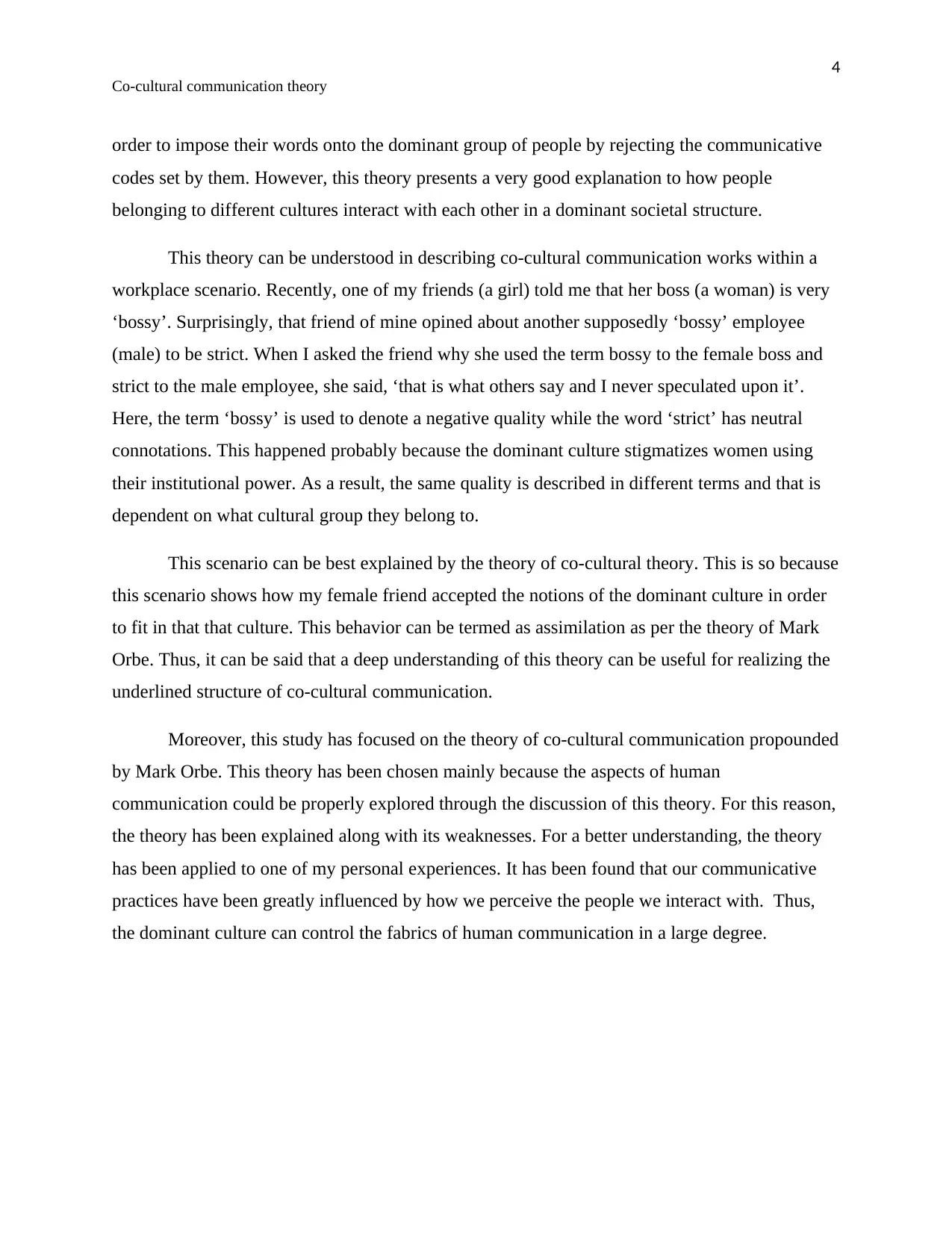
4
Co-cultural communication theory
order to impose their words onto the dominant group of people by rejecting the communicative
codes set by them. However, this theory presents a very good explanation to how people
belonging to different cultures interact with each other in a dominant societal structure.
This theory can be understood in describing co-cultural communication works within a
workplace scenario. Recently, one of my friends (a girl) told me that her boss (a woman) is very
‘bossy’. Surprisingly, that friend of mine opined about another supposedly ‘bossy’ employee
(male) to be strict. When I asked the friend why she used the term bossy to the female boss and
strict to the male employee, she said, ‘that is what others say and I never speculated upon it’.
Here, the term ‘bossy’ is used to denote a negative quality while the word ‘strict’ has neutral
connotations. This happened probably because the dominant culture stigmatizes women using
their institutional power. As a result, the same quality is described in different terms and that is
dependent on what cultural group they belong to.
This scenario can be best explained by the theory of co-cultural theory. This is so because
this scenario shows how my female friend accepted the notions of the dominant culture in order
to fit in that that culture. This behavior can be termed as assimilation as per the theory of Mark
Orbe. Thus, it can be said that a deep understanding of this theory can be useful for realizing the
underlined structure of co-cultural communication.
Moreover, this study has focused on the theory of co-cultural communication propounded
by Mark Orbe. This theory has been chosen mainly because the aspects of human
communication could be properly explored through the discussion of this theory. For this reason,
the theory has been explained along with its weaknesses. For a better understanding, the theory
has been applied to one of my personal experiences. It has been found that our communicative
practices have been greatly influenced by how we perceive the people we interact with. Thus,
the dominant culture can control the fabrics of human communication in a large degree.
Co-cultural communication theory
order to impose their words onto the dominant group of people by rejecting the communicative
codes set by them. However, this theory presents a very good explanation to how people
belonging to different cultures interact with each other in a dominant societal structure.
This theory can be understood in describing co-cultural communication works within a
workplace scenario. Recently, one of my friends (a girl) told me that her boss (a woman) is very
‘bossy’. Surprisingly, that friend of mine opined about another supposedly ‘bossy’ employee
(male) to be strict. When I asked the friend why she used the term bossy to the female boss and
strict to the male employee, she said, ‘that is what others say and I never speculated upon it’.
Here, the term ‘bossy’ is used to denote a negative quality while the word ‘strict’ has neutral
connotations. This happened probably because the dominant culture stigmatizes women using
their institutional power. As a result, the same quality is described in different terms and that is
dependent on what cultural group they belong to.
This scenario can be best explained by the theory of co-cultural theory. This is so because
this scenario shows how my female friend accepted the notions of the dominant culture in order
to fit in that that culture. This behavior can be termed as assimilation as per the theory of Mark
Orbe. Thus, it can be said that a deep understanding of this theory can be useful for realizing the
underlined structure of co-cultural communication.
Moreover, this study has focused on the theory of co-cultural communication propounded
by Mark Orbe. This theory has been chosen mainly because the aspects of human
communication could be properly explored through the discussion of this theory. For this reason,
the theory has been explained along with its weaknesses. For a better understanding, the theory
has been applied to one of my personal experiences. It has been found that our communicative
practices have been greatly influenced by how we perceive the people we interact with. Thus,
the dominant culture can control the fabrics of human communication in a large degree.

5
Co-cultural communication theory
Reference list
Bie, B., & Tang, L. (2016). Chinese gay men’s coming out narratives: Connecting social
relationship to co-cultural theory. Journal of International and Intercultural
Communication, 9(4), 351-367. Retrieved on: 30th APRIL, 2019, From:
http://ltang.people.ua.edu/uploads/1/6/6/9/16697670/16_jiic_coming_out.pdf
Castle Bell, G., Hopson, M. C., Weathers, M. R., & Ross, K. A. (2015). From “laying the
foundations” to building the house: Extending Orbe's co-cultural theory to include
“rationalization” as a formal strategy. Communication Studies, 66(1), 1-26. Retrieved on:
30th APRIL, 2019, From:
https://www.tandfonline.com/doi/full/10.1080/10510974.2013.858053
Orbe, M. P. (2016). The Rhetoric of Race, Culture, and Identity: Rachel Dolezal as Co-Cultural
Group Member. Journal of Contemporary Rhetoric, 6. Retrieved on: 30th APRIL, 2019,
From: http://contemporaryrhetoric.com/wp-content/uploads/2017/01/Orbe12_3.pdf
Orbe, M. P., & Batten, C. J. (2017). Diverse Dominant Group Responses to Contemporary Co-
Cultural Concerns: US Intergroup Dynamics in the Trump Era. Journal of Contemporary
Rhetoric, 7(1). Retrieved on: 30th APRIL, 2019, From:
http://contemporaryrhetoric.com/wp-content/uploads/2017/06/Orbe_Batten7_1_2.pdf
Orbe, M. P., Harrison III, R., Kauffman, L. D., & Laurent, V. (2015). Evolutions of Cultural
Contractual Understanding: Exploring Biracial Women's Communicative
Experiences. Howard Journal of Communications, 26(4), 422-443. Retrieved on: 30th
APRIL, 2019, From:
https://www.researchgate.net/profile/Robert_Harrison19/publication/
277573732_Negotiating_cultural_ambiguity_the_role_of_markets_and_consumption_in_
multiracial_identity_development/links/5677dbfc08ae502c99d53028.pdf
Tang, L., Meadows, C., & Li, H. (2019). How gay men’s wives in China practice co-cultural
communication: Culture, identity, and sensemaking. Journal of International and
Intercultural Communication, 1-19. Retrieved on: 30th APRIL, 2019, From:
https://www.researchgate.net/profile/Lu_Tang2/publication/330935701_How_gay_men
Co-cultural communication theory
Reference list
Bie, B., & Tang, L. (2016). Chinese gay men’s coming out narratives: Connecting social
relationship to co-cultural theory. Journal of International and Intercultural
Communication, 9(4), 351-367. Retrieved on: 30th APRIL, 2019, From:
http://ltang.people.ua.edu/uploads/1/6/6/9/16697670/16_jiic_coming_out.pdf
Castle Bell, G., Hopson, M. C., Weathers, M. R., & Ross, K. A. (2015). From “laying the
foundations” to building the house: Extending Orbe's co-cultural theory to include
“rationalization” as a formal strategy. Communication Studies, 66(1), 1-26. Retrieved on:
30th APRIL, 2019, From:
https://www.tandfonline.com/doi/full/10.1080/10510974.2013.858053
Orbe, M. P. (2016). The Rhetoric of Race, Culture, and Identity: Rachel Dolezal as Co-Cultural
Group Member. Journal of Contemporary Rhetoric, 6. Retrieved on: 30th APRIL, 2019,
From: http://contemporaryrhetoric.com/wp-content/uploads/2017/01/Orbe12_3.pdf
Orbe, M. P., & Batten, C. J. (2017). Diverse Dominant Group Responses to Contemporary Co-
Cultural Concerns: US Intergroup Dynamics in the Trump Era. Journal of Contemporary
Rhetoric, 7(1). Retrieved on: 30th APRIL, 2019, From:
http://contemporaryrhetoric.com/wp-content/uploads/2017/06/Orbe_Batten7_1_2.pdf
Orbe, M. P., Harrison III, R., Kauffman, L. D., & Laurent, V. (2015). Evolutions of Cultural
Contractual Understanding: Exploring Biracial Women's Communicative
Experiences. Howard Journal of Communications, 26(4), 422-443. Retrieved on: 30th
APRIL, 2019, From:
https://www.researchgate.net/profile/Robert_Harrison19/publication/
277573732_Negotiating_cultural_ambiguity_the_role_of_markets_and_consumption_in_
multiracial_identity_development/links/5677dbfc08ae502c99d53028.pdf
Tang, L., Meadows, C., & Li, H. (2019). How gay men’s wives in China practice co-cultural
communication: Culture, identity, and sensemaking. Journal of International and
Intercultural Communication, 1-19. Retrieved on: 30th APRIL, 2019, From:
https://www.researchgate.net/profile/Lu_Tang2/publication/330935701_How_gay_men
⊘ This is a preview!⊘
Do you want full access?
Subscribe today to unlock all pages.

Trusted by 1+ million students worldwide
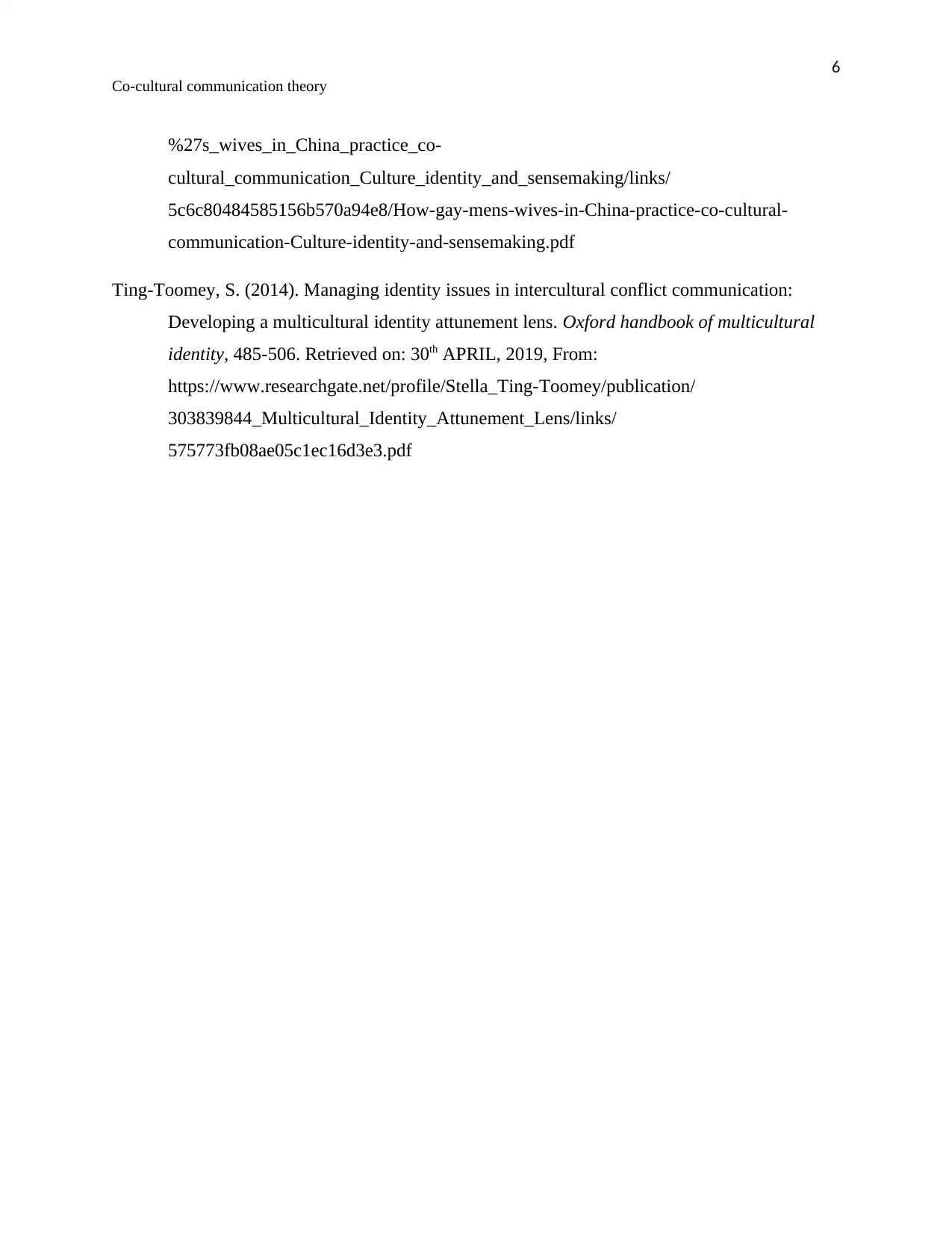
6
Co-cultural communication theory
%27s_wives_in_China_practice_co-
cultural_communication_Culture_identity_and_sensemaking/links/
5c6c80484585156b570a94e8/How-gay-mens-wives-in-China-practice-co-cultural-
communication-Culture-identity-and-sensemaking.pdf
Ting-Toomey, S. (2014). Managing identity issues in intercultural conflict communication:
Developing a multicultural identity attunement lens. Oxford handbook of multicultural
identity, 485-506. Retrieved on: 30th APRIL, 2019, From:
https://www.researchgate.net/profile/Stella_Ting-Toomey/publication/
303839844_Multicultural_Identity_Attunement_Lens/links/
575773fb08ae05c1ec16d3e3.pdf
Co-cultural communication theory
%27s_wives_in_China_practice_co-
cultural_communication_Culture_identity_and_sensemaking/links/
5c6c80484585156b570a94e8/How-gay-mens-wives-in-China-practice-co-cultural-
communication-Culture-identity-and-sensemaking.pdf
Ting-Toomey, S. (2014). Managing identity issues in intercultural conflict communication:
Developing a multicultural identity attunement lens. Oxford handbook of multicultural
identity, 485-506. Retrieved on: 30th APRIL, 2019, From:
https://www.researchgate.net/profile/Stella_Ting-Toomey/publication/
303839844_Multicultural_Identity_Attunement_Lens/links/
575773fb08ae05c1ec16d3e3.pdf
1 out of 7
Related Documents
Your All-in-One AI-Powered Toolkit for Academic Success.
+13062052269
info@desklib.com
Available 24*7 on WhatsApp / Email
![[object Object]](/_next/static/media/star-bottom.7253800d.svg)
Unlock your academic potential
Copyright © 2020–2025 A2Z Services. All Rights Reserved. Developed and managed by ZUCOL.





